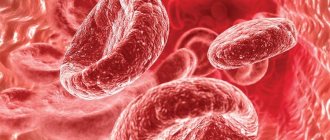Many people are interested in a table that shows the norm of cholesterol in men by age. They want to see it because they have heard more than once about how harmful “bad” cholesterol is, how important it is to monitor it, and that it can increase the risk of developing cardiovascular diseases and atherosclerosis.
But do these statements correspond to reality, how does the level of cholesterol in the blood of men change with age and how can it be lowered? Let's talk about everything in order.
What is cholesterol
Cholesterol is a waxy, fat-like organic compound found in all cells of our body. It is produced by the liver, and cholesterol is also found in a number of foods, such as meat or milk.
Cholesterol is vital for the body, as it is actively involved in the production of vitamin D, as well as various steroid hormones.
How is blood cholesterol measured?
A blood test for cholesterol is called a lipid profile, or lipid profile. It includes several main indicators:
- total cholesterol (TC);
- high-density lipoprotein (HDL) cholesterol—also known as “good” cholesterol;
- low-density lipoprotein (LDL) cholesterol—called “bad” cholesterol;
- triglycerides (TG).
Description of the substance and its functions
Chemical properties: able to dissolve only in fat-containing and organic solvents, not in water. Most of it is produced by hepatocytes - liver cells, about 20% comes with food.
The molecule is a necessary component for the synthesis of vitamins D, as well as sex hormones, including testosterone. In addition, the substance is necessary to maintain the elasticity of the cytoplasmic membrane of the cell over a wide temperature range.
Types of lipoprotein complexes
Due to its insolubility in aqueous solvents, the molecule cannot be transported through blood vessels to organs and tissues. Therefore, the substance is found in the human body in the form of a complex with transporter peptides. The complex is called lipoprotein. There are 3 types of lipoprotein complexes: high density (HDL), low (LDL) and very low (VLDL). They differ not only in the functions they perform, but also in the degree of danger to human health.
How to recognize “good” and “bad” lipoprotein? HDL is considered “good” and makes up approximately 30% of the total. The complex consists predominantly of a peptide part. While LDL contains only a small protein part. The accumulation leads to the formation of plaques in the blood vessels, which impede the free flow of blood, and also increases the risk of developing heart pathologies (heart attack and stroke).
The main part of LDL enters the human body along with fatty foods (meat or dairy), leading to its increase to critical values.
How to prepare for a lipid profile
Anyone can take a lipid profile, but you should prepare for this procedure in advance, otherwise the indicators may be inaccurate. If you are planning to take this test, then ideally you should not drink alcohol for three days or at least a day before going to the clinic.
The night before, refrain from having a heavy dinner with fried, fatty or sweet foods. Try to eat early - no later than 20:00. In the morning - no coffee, tea, mineral water, juice or other sweet drinks - you can only drink plain water.
If you are taking any medications or biologically active substances, check with your doctor whether you can take them before the test, or they may distort the data.
Cholesterol: normal for men by age
Only a doctor should interpret the results obtained after a lipid profile, since healthy and elevated indicators will vary from person to person and depend on many different factors, ranging from his lifestyle to the time of year.
One of the main parameters influencing high cholesterol in men is age. The older we get, the more cholesterol our bodies produce. Below are the average levels of cholesterol in the blood of men at different periods of life.
| Age | Total cholesterol | LDL | HDL |
| 20-25 years | 3.16 — 5.59 | 1.71 — 3.81 | 0.78 — 1.63 |
| 25-30 years | 3.44 — 6.32 | 1.81 — 4.27 | 0.80 — 1.63 |
| 30-35 years | 3.57 — 6.58 | 2.02 — 4.79 | 0.72 — 1.63 |
| 35-40 years | 3.63 — 6.99 | 1.94 — 4.45 | 0.88 — 2.12 |
| 40-45 years | 3.91 — 6.94 | 2.25 — 4.82 | 0.70 — 1.73 |
| 45-50 years | 4.09 — 7.15 | 2.51 — 5.23 | 0.78 — 1.66 |
| 50-55 years | 4.09 — 7.17 | 2.31 — 5.10 | 0.72 — 1.63 |
Doctors recommend that healthy men undergo a lipid profile every 4-6 years to monitor rising cholesterol levels.
Causes of high and low cholesterol
In women and men over 40 years of age, excess cholesterol in the blood may be associated with genetic defects in lipid metabolism, but more often the cause remains unknown. Factors that contribute to increased blood cholesterol levels include:
- liver and gallbladder diseases;
- smoking;
- tumors of the pancreas, prostate gland;
- gout;
- chronic renal failure (the causes and treatment of kidney disease in women are described here);
- endocrine pathology (insufficient production of somatotropic hormone, diabetes mellitus, hypothyroidism).
In women, the cause of increased blood cholesterol compared to the norm can be pregnancy. Those who are planning to get pregnant after 40 need to know this.
Reduced lipid values are observed with:
- Normal blood sugar (glucose level): table by age
- starvation, exhaustion;
- extensive burns;
- severe infections (treated by an infectious disease specialist);
- sepsis;
- malignant liver tumors (diagnosed and treated by an oncologist);
- some types of anemia;
- chronic lung diseases (read how to treat chronic bronchitis in this article);
- rheumatoid arthritis;
- hyperthyroidism.
Low blood lipid levels also occur in those who are vegetarians or take medications such as neomycin, thyroxine, ketoconazole, interferon, and estrogens.
The relationship between cholesterol and cardiovascular disease
For half a century, high total cholesterol (TC) or low-density lipoprotein cholesterol (LDL) has been recognized as a major cause of atherosclerosis and cardiovascular disease (CVD), and statin treatment has been widely advocated for the prevention of CVD.
However, more people are realizing that these mechanisms are more complex and that statin treatment, especially when used as primary prevention, is of questionable benefit.
In 2021, a truly revolutionary study by 15 scientists from around the world was published in the specialized journal Expert Review of Clinical Pharmacology, who questioned the link between high cholesterol levels and the risk of developing cardiovascular diseases.
The hypothesis that high total cholesterol (TC) causes cardiovascular disease (CVD) was put forward in the 1960s by the authors of the Framingham Heart Study.
However, in their 30-year follow-up study published in 1987, the authors reported that “for every 1 mg/dL per year decrease in TC, there was an eleven percent increase in coronary and all-cause mortality.”
In the years following the Framingham Heart Study report, numerous studies have shown that high TC is not associated with future CVD risk.
For example, a 2004 Austrian study including 67,413 men and 82,237 women who were followed for many years found that AC was weakly associated with mortality from coronary heart disease in men, except for those aged 50 to 64. years.
There was also no association between TC and mortality due to other CVDs, except that low TC was inversely associated with CVD mortality in women over 60 years of age.
Today, the general consensus is that total cholesterol is not the most useful or accurate predictor of CVD, and interest is increasingly focusing on low-density lipoprotein (LDL) cholesterol.
If high levels of “bad” cholesterol (LDL) are the culprit of cardiovascular disease, then this indicator should be higher than normal in patients with CVD.
However, in a large American study of nearly 140,000 patients with acute myocardial infarction, LDL levels were actually below normal at hospital admission.
In another study with the same conclusion, the authors decided to further lower patients' LDL levels, but at three-year follow-up, overall mortality among patients with bad cholesterol below 105 mg/dL (2 mmol/L) was twice as high. than in patients with higher LDL levels.
Reverse causation has been proposed to explain the inverse association between mortality and LDL levels; for example, that cancer and infections can lower levels of “bad” cholesterol.
However, a more likely explanation, according to the authors of the study, is that cardiovascular disease can be caused by infections and that LDL directly inactivates almost all types of microorganisms and their toxic products.
Consistent with this finding is the observation that healthy people with low levels of bad cholesterol have an increased risk of both infectious diseases and cancer. The latter is possible because microorganisms have been linked to almost 20% of all cancer types.
Risk groups for high cholesterol
It has been proven that hypercholesterolemia occurs more often in people who:
- eat large amounts of animal fats;
- move little;
- are overweight;
- abuse alcohol;
- smoke;
- take certain medications for a long time (androgens, diuretics, glucocorticoids, cyclosporine, amiodarone, levodopa).
Men over 40 and women over 50 undergo a screening test for blood cholesterol (the norm is indicated in the tables above). It is one of the factors that is taken into account when calculating absolute cardiovascular risk.
Doctor's adviceNutrition for low cholesterol. You can eat any kind of porridge. If you have poor tolerance to milk protein, you can cook them with water, but it is better with half and half milk and water. There is little cholesterol in milk, especially store-bought milk, but the body needs protein. You can add 1/2 teaspoon of natural butter without vegetable fat to the finished porridge. You can eat this 2-3 times a week. On other days, the porridge should be seasoned with vegetable oil. Today, olive oil is considered the most beneficial in terms of cholesterol. You can also use regular sunflower, sea buckthorn, and camelina. Rapeseed should not be used. Salads should also be seasoned with butter or 10% sour cream instead of mayonnaise.
Victoria DruzhikinaNeurologist, Therapist
High and very high absolute risk means that in the coming years a person may suffer from severe and even fatal disorders of the heart and blood vessels.
Hypercholesterolemia is especially dangerous for people suffering from:
- coronary heart disease (therapy is carried out and advised by a cardiologist);
- atherosclerosis of the lower extremities;
- obesity;
- people prone to blood clots;
- chronic kidney diseases;
- hypertension;
- chronic kidney diseases;
- hypertension;
- diabetes mellitus (treated by an endocrinologist);
- collagenoses (for example, rheumatoid arthritis).
These conditions require frequent monitoring of lipids and drug correction if they increase.
The relationship between cholesterol and atherosclerosis
If high total cholesterol (TC) causes atherosclerosis, then it is logical to assume that people with high total cholesterol (TC) should have more cases of atherosclerosis than people with low total cholesterol.
However, in 1936, scientists Lande and Sperry found that, after adjusting for age, people with low TC had the same chance of becoming atherosclerotic as people with high TC. Since then, their observation has been confirmed in at least a dozen studies.
A weak association between AC and the degree of atherosclerosis has been found in some studies, but the authors studied only patients admitted to hospital and therefore may have included patients with familial hypercholesterolemia (blood lipid disorders).
Because the percentage of such patients in the cardiology department is significantly higher than in the general population, the data may have been biased. If high TC levels were indeed the main cause of atherosclerosis, then a corresponding response should be observed in trials of cholesterol-lowering drugs.
For example, the arteries of those people whose lipid levels were most reduced would be healthier. However, in a review of 16 cholesterol-lowering studies, this correlation was present in only one of them, and in that study the only treatment was exercise.
How many should women have?
The normal cholesterol content in women corresponds to that in men – 3.5-6.5 mmol/l and does not depend on age.
At 50
After 50 years, most women experience menopause, which is characterized by a decrease in the content of all sex hormones. This causes cholesterol levels to rise and go beyond normal limits. Therefore, during this period it is important to monitor the values of this substance and correct its level with the help of medications - statins.
At 60 years old
Once a woman passes age 60, her comorbidities often place her at moderate or high risk. These categories of women need constant examination of lipid metabolism, where total cholesterol of 4 mmol/l is acceptable. Diet recommendations for women.










